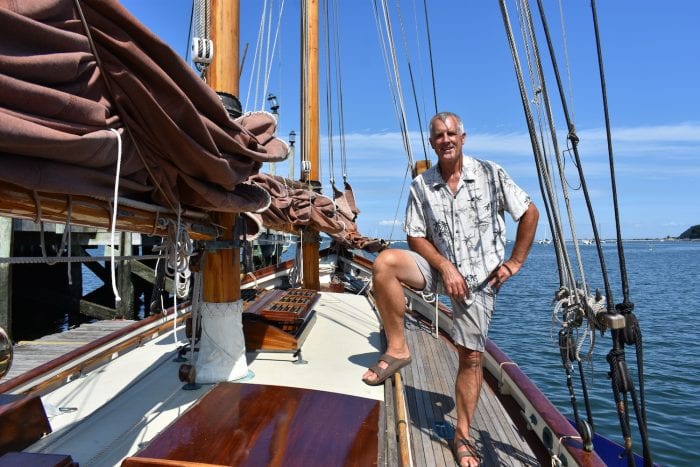Talking to the conductor once the STEM engine comes to a halt, it’s clear that for nonprofits pushing for education among young people, the track ahead is still uncertain.
Like many nonprofits, the Long Island Explorium in Port Jeff, a small haven for interactive learning on the North Shore, has been hit hard by the pandemic, but since so much of its revenue depends on schools’ field trips, the onus has shifted to a virtual approach. That, however, is something difficult for a learning center that has long emphasized interactivity.
Angeline Judex, the executive director of the explorium, said that once COVID-19 hit Long Island, her space along East Broadway was closed, while her museum employees were furloughed and her volunteers sent home. It would take until the end of April before she finally received her Paycheck Protection Program loans from the federal government, and she was able to rehire several people to help with administrative tasks. Their PPP loans will likely be exhausted by the end of July, Judex said.
Meanwhile, all their teaching apparatus was transported online, specifically to video conferencing app Zoom. Keeping some of their regulars who often came to the explorium, they were able to transform one planned field trip into an online field trip, but the vast majority of booked school trips were canceled once the pandemic hit.
Judex said the situation has made the explorium learn to innovate in new ways. So far they have conducted more than 80 live STEM workshops including a virtual science fair, impacting approximately 120 families and 400 students over the past few months. She said general reaction to the programming has been positive from parents and teachers alike.
“The Explorium will continue to scale up and expand on their virtual offerings over summer and beyond to ensure that students of all means, abilities and needs have access to high quality STEM programming,” she said.
One of the benefits of the last few years is that the explorium has started to diversify its revenue streams, from grants, school districts as well as individual donors. The explorium remains financially solvent, she said, despite the obvious hits from the pandemic. Much of their revenue normally came from their work with local school districts, so depending on how well districts are in the fall, which also depends on whether New York State will slash school aid, could leave the nonprofit without 30 to 40 percent of its normal revenue stream.
“We’re hoping schools have this one year to get back to normal, and by hopefully next year things will get better again,” Judex said.
The explorium is tentatively planning to open the museum location in August, though it will only be for private sessions, and how they do will determine if the place remains open for the rest of the fall. If not, then the museum has plans to open again in spring of 2021. Currently, she said the nonprofit has enough funds in the coffers to survive until then.
“As a children’s museum, it’s supposed to be a high touch environment, but if they’re not allowed to touch anything, what are they going to do?” the executive director said. “That’s a huge challenge for museums everywhere, not only mine.”
After several months of hosting learning online, the challenges of keeping students’ attention became apparent. At first, Judex found their online programs became very popular, then when schools started to catch up with computer-based schoolwork, demand dropped. By April and May, she said students were tired of completing schoolwork on a computer and listening to teachers online. Judex said she’s finding the same challenge with her own children doing schoolwork from home.
“I think I’m Zoomed out,” Judex said. “Meeting in person, there’s so much more warmth to it, whereas on a screen you have to make due. Several months of making due in virtual meetings, it was just too much.”
The explorium has three virtual summer camps coming up in the next few months, with the first one including 14 kids. The next, Judex estimated, will likely contain just 10 children.
She said her team found hosting a single Zoom call with 30 students to be nearly impossible, and they are loath to sacrifice the quality of their learning apparatus in order to facilitate more kids per group.
“We’re not compromising on the quality of the experience,” she said.
Still, Judex said the online programs were well-received.
“The pandemic allowed us to focus even more on our mission of meeting the needs of all students regardless of means, abilities and needs as well as advance our strategic plan to explore distance learning,” she said.
Port Jefferson village Mayor Margot Garant said multiple nonprofits in the village have struggled to maintain during the worst months of the pandemic. The building the Long Island Explorium occupies right next to the Village Center is in year 12 of a 20-year lease and they are up to date with their rent at $750 a month.
The explorium requested some kind of rent relief, and at its July 20 meeting, the village board unanimously voted to reduce the nonprofit’s rent by $250 so as to cover utilities.
“It’s real tangible support, that every little bit counts,” Judex said.
Towards the end of summer, the explorium is crafting its Reimagining the Future strategic plan with steering committees set up with members of the community. This would outline how our explorium will move forward in the next stage of the pandemic.
One of the most well-known activities for the explorium is the annual Maker Faire in Port Jeff. This year’s event got pushed back from June to September, but this week it was announced that all of maker faires in New York State were combining forces to host the online Empire State Maker Faire Oct. 16 and 17, including demonstrations of art, crafts, technology and robotics. The event is free and open to the public.
People can offer support to the explorium at: longislandexplorium.org/support-us/ or visit the website for a full list of programs at www.longislandexplorium.org.
This article was updated to include info about the Explorium’s future strategic plans.
This article was updated July 30 to add extra info about the explorium’s online learning live streams.






























